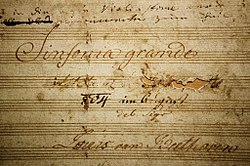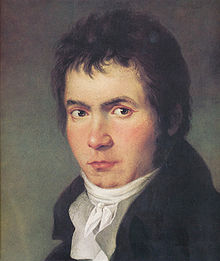Symphony No. 3 (Beethoven)

Ludwig van Beethoven's Symphony No. 3 in E flat major (Op. 55), also known as the Eroica (Italian for "heroic"), is a landmark musical work marking the full arrival of the composer's "middle-period," a series of unprecedented large scale works of emotional depth and structural rigor.[1][2]
The symphony is widely regarded as a mature expression of the classical style of the late eighteenth century that also exhibits defining features of the romantic style that would hold sway in the nineteenth century. The Third was begun immediately after the Second, completed in August 1804, and first performed 7 April 1805.[3]
Instrumentation
The symphony is scored for 2 flutes, 2 oboes, 2 clarinets in B flat, 2 bassoons, 3 horns in E flat, 2 trumpets in E flat and C, timpani in E flat and B flat and strings.
Structure
The piece consists of four movements:
- Allegro con brio
- Marcia funebre: Adagio assai in C minor
- Scherzo: Allegro vivace
- Finale: Allegro molto
Overview

Dedication and premiere
Beethoven had originally conceived of dedicating the symphony to Napoleon Bonaparte. The biographer Maynard Solomon relates that Beethoven admired the ideals of the French Revolution, and Napoleon as their embodiment. In the autumn the composer began to have second thoughts about that dedication. It would have deprived him of a fee that he would receive if he instead dedicated the symphony to Prince Franz Joseph Maximillian Lobkowitz. Nevertheless, he still gave the work the title of Bonaparte.
According to Beethoven's pupil and assistant, Ferdinand Ries, when Napoleon proclaimed himself Emperor of the French in May 1804, Beethoven became disgusted and went to the table where the completed score lay. He took hold of the title-page and tore it up in rage. This is the account of the scene as told by Ries:
In writing this symphony Beethoven had been thinking of Buonaparte, but Buonaparte while he was First Consul. At that time Beethoven had the highest esteem for him and compared him to the greatest consuls of ancient Rome. Not only I, but many of Beethoven's closer friends, saw this symphony on his table, beautifully copied in manuscript, with the word "Buonaparte" inscribed at the very top of the title-page and "Ludwig van Beethoven" at the very bottom. …I was the first to tell him the news that Buonaparte had declared himself Emperor, whereupon he broke into a rage and exclaimed, "So he is no more than a common mortal! Now, too, he will tread under foot all the rights of man, indulge only his ambition; now he will think himself superior to all men, become a tyrant!" Beethoven went to the table, seized the top of the title-page, tore it in half and threw it on the floor. The page had to be re-copied and it was only now that the symphony received the title "Sinfonia eroica."[4]
There exists also the copy of the score made by a copyist, where the words Intitulata Bonaparte ('dedicated to Bonaparte') are scratched out, but four lines below that were later added in pencil the words Geschriben auf Bonaparte ('written in honor of Bonaparte'). Further, in August 1804, merely three months after the legendary tearing-up scene, Beethoven wrote to his publisher that "The title of the symphony is really Bonaparte." The final title that was applied to the work when it was first published in October, 1806, was Sinfonia Eroica...composta per festeggiare il sovvenire di un grand Uomo ("heroic symphony, composed to celebrate the memory of a great man").[5] In addition, Schindler tells us that upon hearing of the Emperor's death in Saint Helena in 1821, Beethoven proclaimed "I wrote the music for this sad event seventeen years ago" – referring to the Funeral March (second movement).
Beethoven wrote most of the symphony in late 1803 and completed it in early 1804. The symphony was premiered privately in summer 1804 in his patron Prince Lobkowitz's castle Eisenberg (Jezeri) in Bohemia. The first public performance was given in Vienna's Theater an der Wien on 7 April 1805 with the composer conducting. For that performance, the work's key was announced as "Dis", the German for D-sharp.[6]
Musical characteristics and uniqueness
The work is a milestone in the history of the classical symphony for a number of reasons. The piece is about twice as long as symphonies by Haydn or Mozart—the first movement alone is almost as long as many Classical symphonies, if the exposition repeat is observed. The work covers more emotional ground than earlier works had, and is often cited as the beginning of the Romantic period in music.[7] The second movement, in particular, displays a great range of emotion, from the misery of the main funeral march theme, to the relative solace of happier, major key episodes. The finale of the symphony shows a similar range, and is given an importance in the overall scheme which was virtually unheard of previously[7] —whereas in earlier symphonies, the finale was a quick and breezy finishing off, here it is a lengthy set of variations and fugue on a theme Beethoven had originally written for his ballet music The Creatures of Prometheus.
Reception
According to Harold C. Schonberg, “Musical Vienna was divided on the merits of the Eroica. Some called it Beethoven’s masterpiece. Others said that the work merely illustrated a striving for originality that did not come off.”[8] A Symphony in E flat major by Anton Eberl (1765–1807) was premiered at the same concert, and it received rather more positive reviews than Beethoven's did.[6]
Music critic J. W. N. Sullivan writes[9] that the first movement is an expression of Beethoven's courage in confronting his deafness, the second, slow and dirgelike, depicting the overwhelming despair he felt, the third, the scherzo, an "indomitable uprising of creative energy" and the fourth an exuberant outpouring of creative energy. Hector Berlioz discussed Beethoven’s use of the horn and the oboe in his Treatise on Orchestration.
Writers on art from the Marxist tradition often seize on the Eroica. Gareth Jenkins wrote that "Beethoven was doing for music what Napoleon was doing for society—turning tradition upside down", and that the symphony embodied a "sense of human potential and freedom" first seen in the period of the French Revolution.[10]
Richard Strauss's mourning music Metamorphosen is based on the theme of the funeral march from the Eroica, and combines harmonically distorted variants of its main motifs. At the very end the opening bars of the funeral march are quoted literally in the bass.
Horn solo anecdote
In the first movement, the solo horn enters with the main theme four bars before the "real" recapitulation. Beethoven's disciple Ferdinand Ries recounted:[11]
The first rehearsal of the symphony was terrible, but the hornist did in fact come in on cue. I was standing next to Beethoven and, believing that he had made a wrong entrance, I said, 'That damned hornist! Can't he count? It sounds frightfully wrong.' I believe I was in danger of getting my ears boxed. Beethoven did not forgive me for a long time.
Use of second movement in funerals
- The second movement, a funeral march, is frequently performed on memorial occasions. Serge Koussevitzky performed it to commemorate the death of President Franklin Delano Roosevelt,[12] and Bruno Walter performed the entire symphony at the memorial concert for Arturo Toscanini.[13] It was also performed at the funeral of Felix Mendelssohn in 1847.[14]
- The second movement was also used as a funeral dirge during the memorial service following the "Munich massacre" terrorist attacks during the 1972 Summer Olympics. It was played by the Munich Philharmonic Orchestra.[15]
Eroica on screen
In 2003 a Simon Cellan Jones-directed BBC / Opus Arte made-for-television film, Eroica, was released, with Ian Hart as Beethoven. The Orchestre Révolutionnaire et Romantique, conducted by Sir John Eliot Gardiner, performs the Eroica Symphony in its entirety. The subject of the film is the private 1804 premiere of the Eroica Symphony at the palace of Prince Lobkowitz (played by Jack Davenport). The film is based in part on Ferdinand Ries' recollections of the event.[16]
In the film Beethoven does not learn that Napoleon has crowned himself Emperor of France until after the performance of the symphony is over – while having dinner with Ferdinand Ries. Rather than tearing up the title page of the symphony, he simply crumples it up.
In 1994, portions of the Eroica were used in the biographical film, Immortal Beloved starring Gary Oldman as Beethoven. Written and directed by Bernard Rose, the film's score uses various works of Beethoven that were selected by the film's music director, Sir Georg Solti.
Notes
- ^ The Symphony, ed. Ralph Hill, Pelican Books (1949), pg.99
- ^ Symphony No. 6 in F Major, Op. 68 Pastorale (Schott), ed. Max Unger, pg. vi
- ^ Beethoven, Kegan, Paul, Trench, Trubner & Co., London, 1930, pg. 112
- ^ Eroica, Napoleon Series.
- ^ Dahlhaus, Carl. Ludwig van Beethoven, Approaches to his Music. Clarendon Press, 1991, pp. 23–25
- ^ a b Grove's Dictionary of Music and Musicians, 5th ed., 1954, Eric Blom, ed.
- ^ a b Bernstein, Leonard, The Infinite Variety of Music, Hal Leonard Corporation, ISBN 978-1-57467-164-3
- ^ Aaron Green. "Historical Notes on Ludwig van Beethoven's Symphony No. 3, Op. 55." About.com http://classicalmusic.about.com/od/symphonies/a/aaeroica.htm
- ^ Eroica Symphony, Wiſdom Portal.
- ^ Gareth Jenkins. "Beethoven's cry of freedom" Socialist Worker (UK) 4 October 2003. http://www.socialistworker.co.uk/art.php?id=2496
- ^ Ries, Ferdinand (1987). Beethoven Remembered: The Biographical Notes of Franz Wegeler and Ferdinand Ries. Arlington, Va.: Great Ocean Publishers. p. 69. ISBN 0-915556-15-4.
{{cite book}}: Unknown parameter|coauthors=ignored (|author=suggested) (help) - ^ American Heritage.
- ^ Music and Arts.
- ^ Wilfrid Blunt, On Wings of Song, a biography of Felix Mendelssohn, London 1974.
- ^ Youtube
- ^ Eroica at IMDb
References
- George, Christopher T. (December 1998). "Beethoven: Letters, Journals and Conversations". Napoleonic Scholarship:The Journal of the International Napoleonic Society. Vol. 1, no. 2. ISBN 0-8371-9899-2.
{{cite news}}:|contribution=ignored (help)
External links
- Complete Eroica Discography
- A site about the Eroica.
- Full Score of Beethoven's Third Symphony.
- Program notes for the Philadelphia Orchestra.
- Template:MUSEDATA
- Free scores by Symphony No. 3 at the International Music Score Library Project (IMSLP)
- Media:
- Eroica website from SF Symphony's 'Keeping Score' with Analysis, Background and Commentary by Michael Tilson Thomas (needs Flash).
- Discovering Music, BBC Radio 3. Videos of an analysis and complete performance of the symphony. The analysis is by Stephen Johnson and the symphony is performed by the BBC National Orchestra of Wales, under Christophe Mangou. Listening notes for the symphony are also available here.
- The Eroica Effect, Helsingborg Concert Hall. Complete performance of the symphony. The symphony is performed by the Helsingborg Symphony Orchestra, under Andrew Manze.
